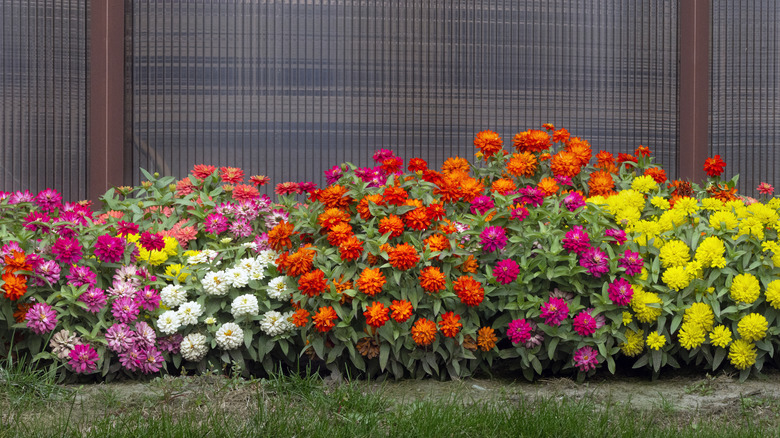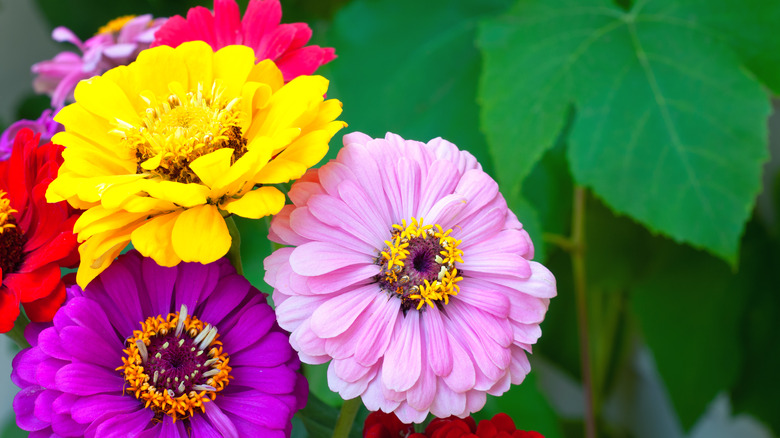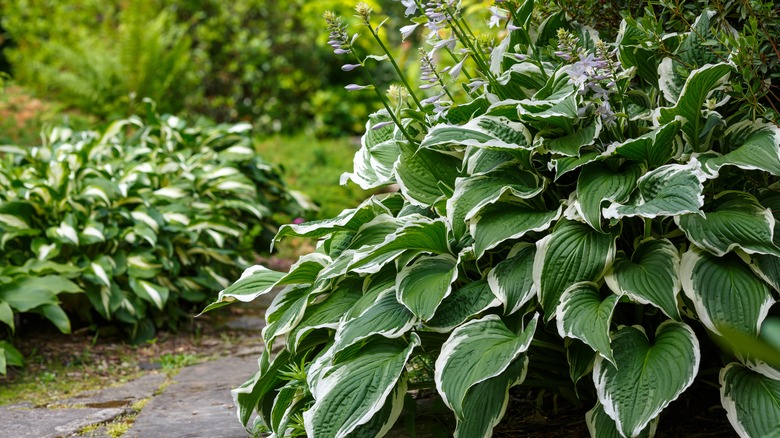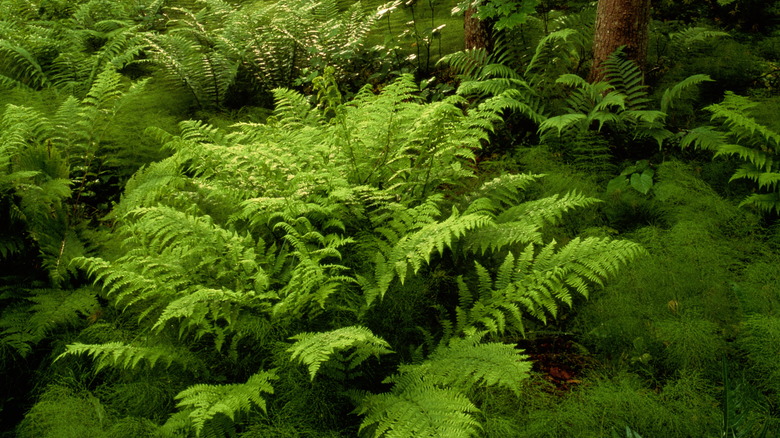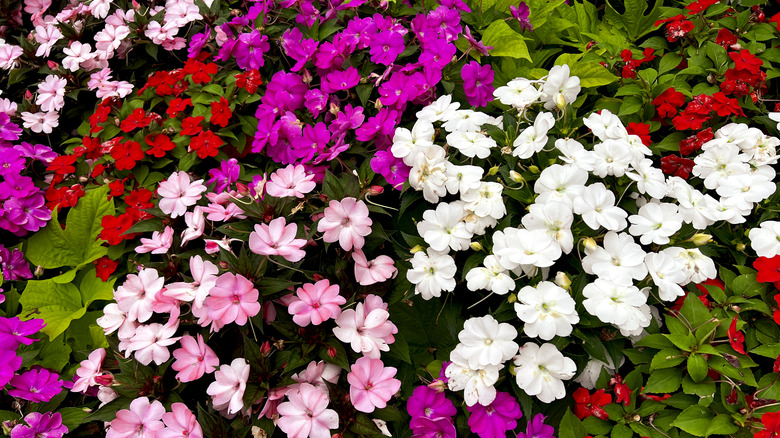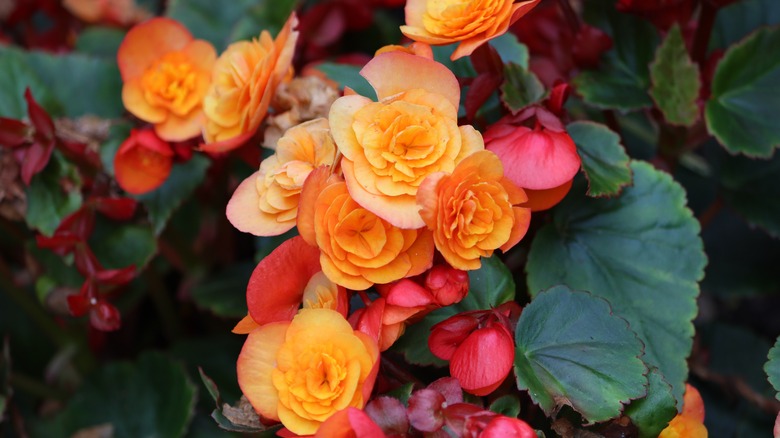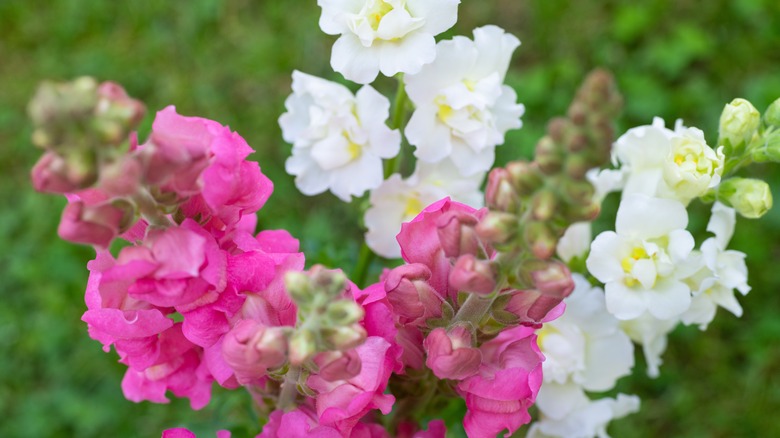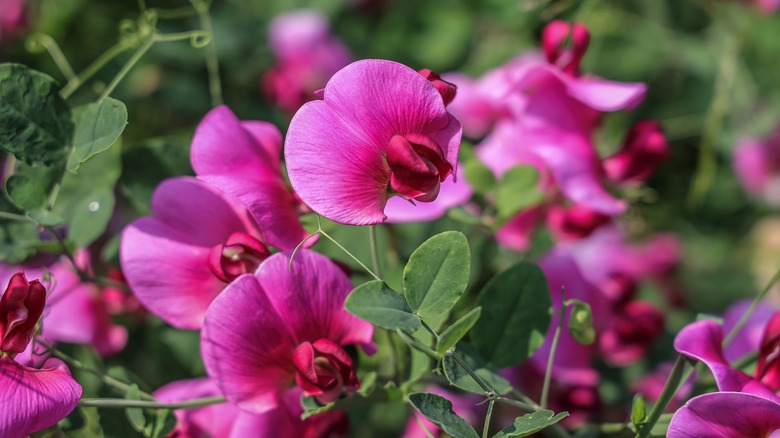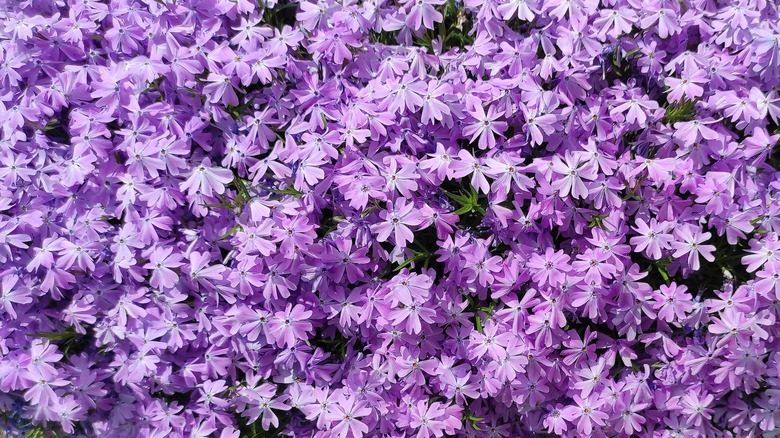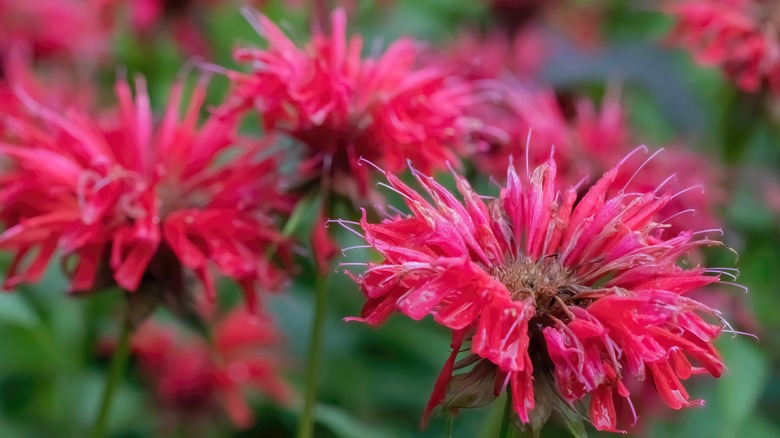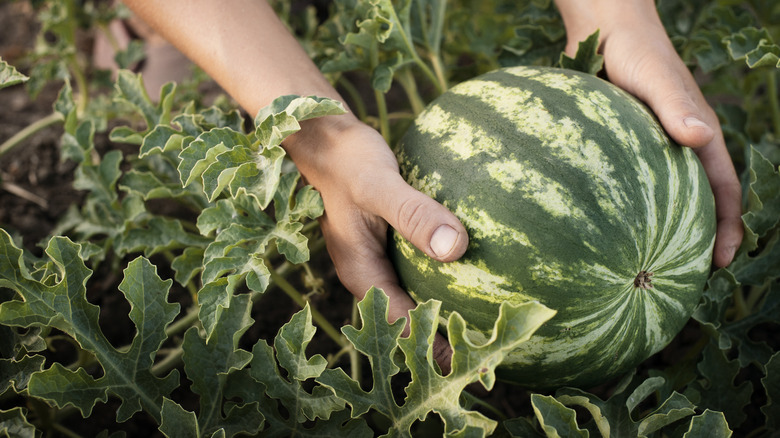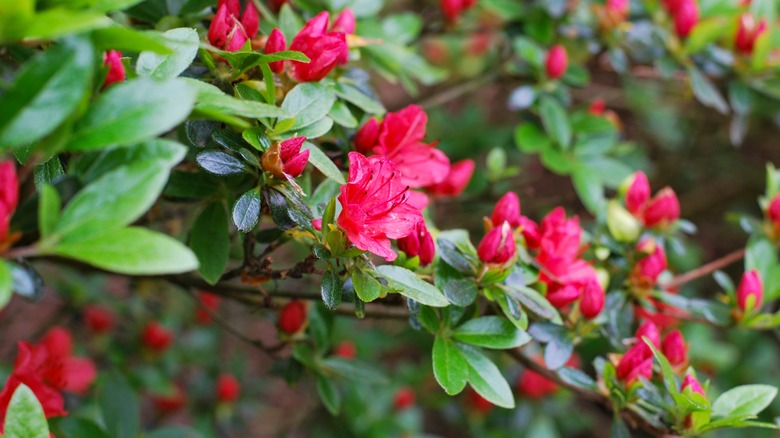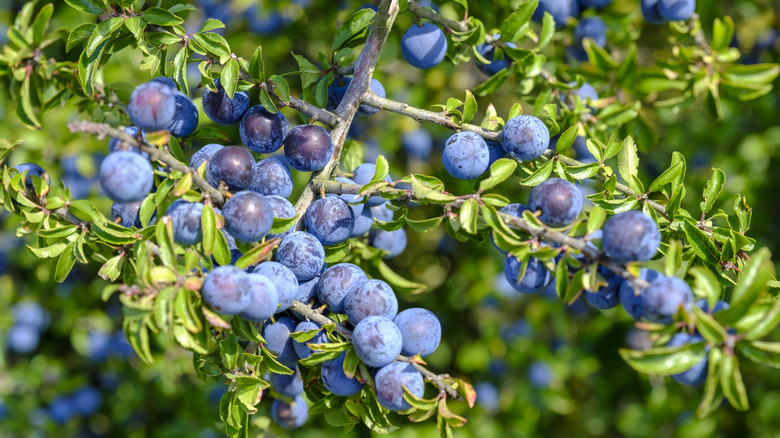Popular Plants You Shouldn't Grow Near Zinnias In The Garden
Zinnias make great additions for gardens of any size thanks to their ability to handle most growing conditions. They're drought-tolerant, butterflies love them (which is why they're often ranked as one of the best flowers for pollinator gardens), and they make excellent neighbors for a number of herbs and flowers. But despite them being in the "cool kids" section of the garden, there are some plants they don't play well with, no matter how hard you try to make it work.
Therefore, before you break out the credit card at the garden center, here are the plants you should skip buying if you already have zinnias in your garden. We'll break down why they don't play nice with zinnias (most have to do with conflicting growth preferences, such as sun and soil moisture), and we'll also offer a few ideas for alternatives that could give you the same aesthetic appeal without the hassle.
First, let's recap what zinnias need to thrive
Like we said above, zinnias overall are fairly chill flowers to keep in a garden because they don't need much to thrive. However, we thought it'd be a good idea to do a quick recap of what they need as a quick reference point to help you understand what the disconnect is between zinnias and the following clashing plants.
Zinnias prefer full sun conditions, but really need at least six hours of direct sun on their blooms per day. They're native to Mexico and Central America, so they absolutely adore hot weather and will do best in warmer climates; too cold of temperatures will cause those pretty flowers to wilt pretty quickly. While they're drought-tolerant and can handle most soil conditions, they still need a drink of water occasionally. However, don't give them too much, as they're prone to fungal diseases and powdery mildew, which comes from overly wet foliage and soil. Speaking of which, they'd prefer if their soil was well-draining and mostly neutral, sticking to a pH range of 5.5 to 7.5.
Hostas need more shade than zinnias can handle
Hostas (Hosta plantaginea) are fantastic plants for gardeners who kill anything they touch. They're incredibly easy to grow, live for years, and you can make new hostas simply by splitting them with a shovel. They come in a wide range of leaf colors and sizes, but generally all have the same growing requirements that would be a hostile (or "a hosta," if you're into puns) environment for zinnias. Hostas need shade and want soil that can retain some moisture, while zinnias prefer those bright, sunny days and well-draining soil that keeps their foliage and roots on the drier side. In the end, one of these plants will be pretty sad next to the other; it just depends on which one's growing conditions they're living in.
Some hostas can tolerate a little more sun, so you might try yellow-leaf cultivars like the 'Sum and Substance' or 'Dixie Chick' variegated species. However, it's better to opt for plants that mimic the look of hostas and naturally prefer full sun and well-draining soil, like coral bells (Heuchera americana) or the kaleidoscope abelia (Abelia x grandiflora 'Kaleidoscope'). If you already have hostas and want to mimic zinnia's colorful bloom, try more shade-thriving, moist soil-loving alternatives like the dog daisy (Bellis perennis), china aster (Callistephus chinensis), or dahlias (Dahlia pinnata).
Ferns will scorch in the full sun zinnias need
Ferns (Polypodiopsida or Polypodiophyta) are amazing, ancient plants that have been around for over 350 million years. Despite their hardy nature (they survived the asteroid strike that killed the dinosaurs, after all), they've adapted to moist soil and shady conditions that would destroy a zinnia almost instantly. We're not sure if the root rot caused by the waterlogged soil or lack of sun would do the zinnia in first; regardless, we think it's better not to try and find out.
If you want to replicate a fern's fronds near your zinnias, the aptly-named fernleaf yarrow (Achillea filipendulina) is a good option that would pair nicely. Other options include the bamboo palm (Chrysalidocarpus lutescens) or the San Gabriel nandina (Nandina domestica 'San Gabriel'). If you prefer a pop of color near your ferns that look like zinnias, try the bush lily (Clivia), sweet William (Dianthus barbatus), or most of the coneflower (Echinacea spp.) cultivars.
Impatiens love the shade that zinnias hate
You'd think that impatiens would be happy alongside zinnias since they're so cheerful-looking, and their mix of colors would complement zinnias perfectly. But impatiens' delicate flower petals will scorch under too much sunlight, while zinnias want all the sun you've got. While you could meet in the middle, since impatiens can handle partial sun, they'd need consistently moist soil, which would mean your zinnias wouldn't be happy. In the end, the compromise would leave you with a "meh" looking garden that could've been prevented by just picking more compatible flower friends.
Both cosmos and the everlasting daisy (Xerochrysum bracteatum) are impatiens-resembling options that come in a variety of colors, like full sun, and would work just as well as zinnias in a pollinator garden. Meanwhile, the common camellia (Camellia japonica), bleeding heart (Lamprocapnos spectabilis), and windflower (Anemone x hybrida) would all be happy to live next to impatiens in moist, semi-shady spots.
Begonias are adapted to shadier environments than zinnias prefer
Begonias have always been showstopping flowers to keep around your garden with their bright, happy blooms. Lately, though, several hybrids with incredible leaf designs have given the flowering cultivars a run for their money, moving begonias from the front porch into the IKEA greenhouse cabinet of houseplant enthusiasts around the world. Despite their brightly colored flowers and leaves, begonias aren't meant to be center stage, and a spotlight of full sun would scorch those delicate displays, which makes them a poor candidate for moving into your zinnia garden. Instead, they'd much prefer somewhere a little shady that's full of humidity, and closer to their native tropical origins.
Luckily, some alternatives are pretty close matches to begonias that can better handle the sun and lower humidity zones that make zinnias thrive. Try planting lantana (Lantana camara) or Jolt Pink dianthus (Dianthus x 'Jolt Pink') to match begonia blooms. If you want something with showy leaves that can match rex begonias, try caladiums (just be aware that in full sun, their coloring isn't as brilliant) or the Florida Sunset weigela (Weigela florida 'Sunset'). If you want a zinnia-like flower that thrives in begonia growing conditions, both anthuriums (Anthurium andraeanum) and orchids (Dendrobium) love lots of humidity and reduced light.
Snapdragons prefer moist soil that could lead to zinnia's roots rotting
Snapdragons (Antirrhinum majus) are beloved by gardeners for the crazy huge spectrum of colors they come in and their ability to thrive in containers or in-ground easily. Fun fact: It's believed their flower looks like what a dragon's snout might, so their genus name is a rough translation from Greek that means "snout or nose like." Alas, only the likeness is what they share their fantasy namesakes, because snapdragons are delicate flowers that don't do well in heat or without moist soil. They're just too dainty to hang with zinnias, which thrive in those hot and dry summer days.
In terms of alternatives, the African corn-lily (Ixia) is a close match to the snapdragon, but has soil preferences (well-draining and neutral pH) that better align with zinnias. However, they might be hard to find, so look for the summer snapdragon (Angelonia angustifolia), which can handle higher temps and has better drought tolerance than its common-named cousin. On the other side, winter windflowers (Anemone blanda) love the same growing conditions snapdragons do. Plus, they're teeny tiny plants, growing only six inches high, which would match snapdragons' heights nicer than zinnias. The false dragon head (Physostegia virginiana) would also be a good snapdragon companion — plus you get the bonus of a double dragon-named garden.
Sweet peas love cooler climates while zinnias love the summer heat
The sweet pea (Lathyrus odoratus) is a pretty climbing plant that fits right into Instagram-worthy cottage-style gardens with its pretty, fuchsia pink flowers. But it's a lazy plant that likes to languish in the shade where the temperatures are cool and the soil is moist. Compare that to zinnias, which love hot days, full sun, and grow upright on their own (though some will need support netting if they get too tall) in well-draining soil, and you can see why this is a bad match.
Garden cosmos (Cosmos bipinnatus), bee plant (Cleome), and clary sage (Salvia sclarea) all have pretty pink flowers that can go toe-to-toe with sweet pea's blooms, but fare better in the growing conditions zinnias prefer. For pairing sweet peas with a zinnia-like option, look for climbing companions that also prefer the shade, like the jackman's clematis (Clematis x jackmanii) or climbing hydrangea (Hydrangea anomala).
Some phlox prefer more shade than zinnias do, but not all
Phlox are just easy. They make excellent groundcovers that prevent pesky weeds from your garden and some get so thick with flowers you'll feel like a Disney princess running through your very own meadow of blooms. There are over 70 cultivars of phlox and some are okay with hot summer sun, while others can't hack it. If you want to use phlox to fill in the gaps between your zinnias, it's important you pay attention to which species you're getting so that you're not out the cost of a dead plant and left with a sad-looking garden.
There are two shade-loving phlox you'll need to stay away from. The first is woodland phlox (Phlox divaricata). As for the second, it gets a little confusing, so you'll need to pay attention to the plant tags. There are two cultivars known as creeping phlox: P. stolonifera and P. subuluta. P. subulata, also known as moss phlox or moss pink, is the one you want since it tolerates drought conditions and thrives in full sun exposure. The easiest way to tell the difference is by looking at the leaves: P. stolonifera has oval leaves, while P. subulata's are pointy. But if you'd prefer avoiding the headache altogether, garden phlox (Phlox paniculata) is a popular option that handles full sun easily. However, it's not a spreader and will grow upright alongside zinnias, so keep that in mind if you're specifically looking for groundcovers.
Bee balm is too susceptible to powdery mildew to be next to zinnias
Bee balm (Monarda didyma) is another hot pink knockout. You might also know it as bergamot, especially if you're into using essential oils, as it's a popular scent for soaps and cosmetics. Bee balm does well in full sun and well-draining soil, but it's like zinnias' toxic BFF because it's very susceptible to the same fungal infection zinnias are: powdery mildew. Unfortunately, one flower contracting it most likely means a garden-wide outbreak that could severely damage all of your plants, so it's best to keep these two flowers separate.
If you're dead set on planting bee balm and zinnias together, only do it if you've got a lot of room; powdery mildew is hard to spread when plants have good air circulation around them. However, if you're willing to opt for less fungal-prone alternatives, astersor the bee plant (Cleome) would be good replacements for either zinnias or bee balm, as they're hardy plants that attract pollinators and have no serious disease or fungal issues.
Cucurbits could spread powdery mildew to zinnias too easily
Cucurbits are members of the Cucurbitaceae family and produce crops like squash, melons, and cucumbers. Many vegetable gardeners like to add zinnias to their gardens to help attract pollinators, which improves the chances of better crop yields, but zinnias and cucurbits are too alike in the wrong ways to be put together. While they all like full sun, they're also susceptible to powdery mildew outbreaks, and putting zinnias in rows between your melons or cucumbers could mean a fungal outbreak that results in fewer or smaller fruit yields, premature ripening, and weak plants.
Luckily, farming science has been working hard to tackle this issue and there are now cucurbit cultivars with better resistance to powdery mildew. Cornell University's College of Agriculture and Life Sciences has an incredible database that gives in-depth evaluations of which varieties have proven to be the most resistant — it's worth checking out. However, if you'd prefer to keep things simple, the golden aster (Chrysopsis mariana), blue sage (Salvia azurea), or coneflower (Echinacea purpurea) are all pollinator-attracting flowers that have better powdery mildew resistance than zinnias. If you'd like to use zinnias for companion planting, check out these 11 herbs and flowers that pair well with zinnias in a garden.
Azaleas love soil that's too acidic for zinnias
Okay, let's get a little bit technical here. Azaleas are in the genus Rhododendron, so some people think they're one and the same. While it's true that they generally share the same growing conditions, azaleas may be rhododendrons, but rhododendrons are not necessarily azaleas. Sorry to hurt your brain for a second. Anyhow, azaleas are typically very adaptable plants, except for one area: soil pH. They thrive in acidic soils that have a pH between 4.5 to 6.0. Meanwhile, zinnias top out at around an acidity pH of 5.5. So, while there is some overlap, chances are that one plant may find the soil conditions to be either too acidic or too alkaline for them to flourish.
That said, not all hope is lost, and that 0.5 pH might be enough of an overlap to give it a shot and see what happens. But if you'd prefer to just play it safe, replace your azaleas with a full sun, neutral pH-loving shrub like the glossy abelia (Abelia x grandiflora), "Ruby Slippers" cultivar of the oakleaf hydrangea (Hydrangea quercifolia), or the common crape myrtle (Lagerstoemia indica). If you need a flowery friend for your azalea bush that can handle more acidic soil conditions, try the Madagascar periwinkle (Catharanthus roseus), cornflower (Centaurea cyanus), which vintage Corning Glass collectors may recognize, or black-eyed Susan (Rudbeckia hirta).
Blueberries need acidic soil that zinnias can't handle
Did you know azaleas are part of the blueberry (Eriaceae) family? It's no surprise then that blueberries are also incompatible companion plants for zinnias thanks to their need for acidic soil pH levels, even though the pollinators zinnias bring could really help them out. Blueberry plants need even more acidic soil than azaleas, enjoying anywhere from 4.0 to 5.0, so there's not even an overlap this time to test. If you tried to plant your zinnia in a soil that's too acidic, you'd end up with nutrient-deficient plants that don't give you the full show you're hoping for as they struggle to thrive.
Of course, you could pair your blueberry plant with its sibling, the Azalea, for a nice pollinating attractor plant, but hydrangeas, sansanqua camellias (Camellia sasanqua), and holly (Ilex opaca) are also plants that do well in soils with high acidity. Meanwhile, zinnias have growing requirements that are compatible with a few fruit-producing plants. Try popping a few zinnias around kiwi vines (Actinida chinensis), blackberries (Rubus laciniatus), or go all in with your inner wild child and pair it with the Carolina reaper pepper (Capsicum chinense).
